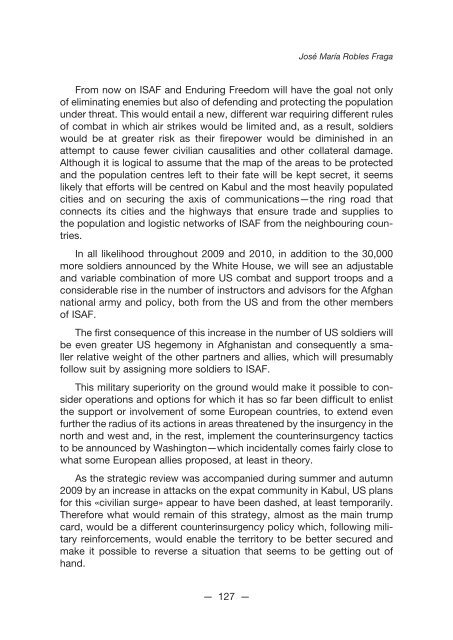Strategic Panorama 2009 - 2010 - IEEE
Strategic Panorama 2009 - 2010 - IEEE
Strategic Panorama 2009 - 2010 - IEEE
Create successful ePaper yourself
Turn your PDF publications into a flip-book with our unique Google optimized e-Paper software.
José María Robles Fraga<br />
From now on ISAF and Enduring Freedom will have the goal not only<br />
of eliminating enemies but also of defending and protecting the population<br />
under threat. This would entail a new, different war requiring different rules<br />
of combat in which air strikes would be limited and, as a result, soldiers<br />
would be at greater risk as their firepower would be diminished in an<br />
attempt to cause fewer civilian causalities and other collateral damage.<br />
Although it is logical to assume that the map of the areas to be protected<br />
and the population centres left to their fate will be kept secret, it seems<br />
likely that efforts will be centred on Kabul and the most heavily populated<br />
cities and on securing the axis of communications—the ring road that<br />
connects its cities and the highways that ensure trade and supplies to<br />
the population and logistic networks of ISAF from the neighbouring countries.<br />
In all likelihood throughout <strong>2009</strong> and <strong>2010</strong>, in addition to the 30,000<br />
more soldiers announced by the White House, we will see an adjustable<br />
and variable combination of more US combat and support troops and a<br />
considerable rise in the number of instructors and advisors for the Afghan<br />
national army and policy, both from the US and from the other members<br />
of ISAF.<br />
The first consequence of this increase in the number of US soldiers will<br />
be even greater US hegemony in Afghanistan and consequently a smaller<br />
relative weight of the other partners and allies, which will presumably<br />
follow suit by assigning more soldiers to ISAF.<br />
This military superiority on the ground would make it possible to consider<br />
operations and options for which it has so far been difficult to enlist<br />
the support or involvement of some European countries, to extend even<br />
further the radius of its actions in areas threatened by the insurgency in the<br />
north and west and, in the rest, implement the counterinsurgency tactics<br />
to be announced by Washington—which incidentally comes fairly close to<br />
what some European allies proposed, at least in theory.<br />
As the strategic review was accompanied during summer and autumn<br />
<strong>2009</strong> by an increase in attacks on the expat community in Kabul, US plans<br />
for this «civilian surge» appear to have been dashed, at least temporarily.<br />
Therefore what would remain of this strategy, almost as the main trump<br />
card, would be a different counterinsurgency policy which, following military<br />
reinforcements, would enable the territory to be better secured and<br />
make it possible to reverse a situation that seems to be getting out of<br />
hand.<br />
— 127 —

















